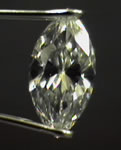 The bow-tie effect, observed with the unaided eye, is frequently found in marquise, oval, radiant, pear and some heart-shaped diamonds, and is considered a negative factor if prominent. It arises from the variations in the pavilion facet angles required in cutting stones, which are longer than they are wide.
The bow-tie effect, observed with the unaided eye, is frequently found in marquise, oval, radiant, pear and some heart-shaped diamonds, and is considered a negative factor if prominent. It arises from the variations in the pavilion facet angles required in cutting stones, which are longer than they are wide.
 The bow tie effect is a result of a small amount of light leaking through the diamond. Facets are suppose to alternate between light and dark as the diamond, viewer or light source are moved but with the bow tie effect, certain facets stay relatively dark regardless of the movement.
The bow tie effect is a result of a small amount of light leaking through the diamond. Facets are suppose to alternate between light and dark as the diamond, viewer or light source are moved but with the bow tie effect, certain facets stay relatively dark regardless of the movement.
 The bow-tie looks like two dark triangular shapes joined at the point in the center of the stone and looks like a man’s black bow tie. Depending on the size, angle and placement of the diamond’s facets, this bow tie can be barely visible (often termed minimal) or very pronounced and everything in between. While almost every elongated stone has some “bow-tie” shadowing, your goal is to find a diamond with minimal bow-tie effect such that the distraction is minimal or absent.
The bow-tie looks like two dark triangular shapes joined at the point in the center of the stone and looks like a man’s black bow tie. Depending on the size, angle and placement of the diamond’s facets, this bow tie can be barely visible (often termed minimal) or very pronounced and everything in between. While almost every elongated stone has some “bow-tie” shadowing, your goal is to find a diamond with minimal bow-tie effect such that the distraction is minimal or absent.
 For the diamond shopper trying to select diamonds based on specifications rather than visual observation, the bow tie effect is a challenge. The numbers on a diamond grading report do not provide assurances concerning the bow tie. Over the years, some rules of thumb have evolved for the different shapes that increase the probability of a minimal bow tie effect. For example, with a marquise shape depth percentages in the low sixties and a crown height close to 14% seems to result in less visible bow tie.
For the diamond shopper trying to select diamonds based on specifications rather than visual observation, the bow tie effect is a challenge. The numbers on a diamond grading report do not provide assurances concerning the bow tie. Over the years, some rules of thumb have evolved for the different shapes that increase the probability of a minimal bow tie effect. For example, with a marquise shape depth percentages in the low sixties and a crown height close to 14% seems to result in less visible bow tie.
However, only visual inspection can determine the true level and perceived significance of the bow tie effect.
